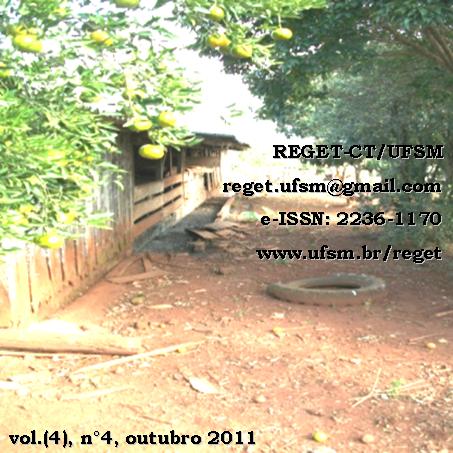AVALIANDO OS IMPACTOS AMBIENTAIS VISUAIS DO ARROIO MONJOLO, EM SANTO CRISTO – RS, NA PERSPECTIVA DE DESENVOLVER AÇÕES DE SUSTENTABILIDADE
DOI:
https://doi.org/10.5902/223611703899Keywords:
Environmental Education, Environmental Visual Impacts, Permanent Preservation Area.Abstract
This research focuses on the environmental impact assessment of the visual stream Monjolo inorder to focusing in developing sustainability initiatives. We tried to make a survey of theenvironmental impacts from the source of the stream Monjolo following the stretch that runsaround the area of the Blue Lagoon Water Park. This research also aimed to investigate theunderstanding that the students of two classes of fifth grade of Public School Leopoldo Ost haveabout the subject, from the point of view of developing environmental education activities thatcontribute to improve the quality of life. The investigation took as a reference the adoption of aqualitative approach as a method to analyze the environmental and demonstrations bystudents. Lectures and interactive conversations were made the subjects in the classroom. Initially the room that led the environmental impacts identified visual field and the students had expressto their opinion about the environmental impact that needs to be helped with more urgency.Secondly tried practical actions that could contribute to environmental improvements in thestream Monjolo. However, the actions undertaken in this project already accomplished at thesource of the stream Monjolo. The students had been committed to separation and properdisposal of the waste. At the school the waste compost receives and sweeping will be used as ateaching tool.
Downloads
References
ARAÚJO, S. M. V. G. de. Área de Preservação Permanente e a questão urbana. Consultoria Legislativa, Brasília, 2002. Disponível em: <http://www.mp.go.gov.br/ portalweb/hp/9/docs/doutrinaparcel_01.pdf>. Acesso em: 04 fev. 2009.
ARENDT, H. A condição humana. Rio de Janeiro: Forense Universitária, 2004. Tradução de Roberto Raposo.
BRASIL, Código de Águas. Disponível em: <http://www.planalto.gov.br/ccivil_03/decreto/d24643.htm >. Acesso em: out. 2010
BRASIL. Lei nº 4.771 de 15 de setembro de 1965. Institui o novo Código Florestal. Disponível em: <http://www.mma.gov.br/port/conama/legiabre.cfm?codlegi=311>. Acesso em: out. 2010
BRASIL. CONAMA Nº 001, de 23 de janeiro de 1986. Define impacto ambiental.
BRASIL. CONAMA nº 237, de 19 de dezembro de 1997. Define o Impacto Ambiental Regional.
BRASIL, Lei nº 9.795, de 27 de abril de 1999. Dispõe sobre a educação ambiental, institui a Política Nacional de Educação Ambiental e dá outras providências Disponível em: <http://www.planalto.gov.br/ccivil_03/Leis/L9795.htm>. Acesso em: out. 2010
BRASIL. Resolução CONAMA 302, de 20 de março de 2002. Dispõe sobre os parâmetros, definições e limites de Áreas de Preservação Permanente de reservatórios artificiais e o regime de uso do entorno. Disponível em:
<http://www.mma.gov.br/port/conama/legiabre. cfm?codlegi=298>. Acesso em: out. 2010.
BRASIL. Resolução CONAMA 303, de 20 de março de 2002. Dispõe sobre parâmetros, definições e limites de Áreas de Preservação Permanente. Disponível em: < http://www.mma.gov.br/ port/ conama/ legiabre.cfm?codlegi=299>. Acesso em out. 2010.
BRASIL. Resolução CONAMA 369 de 28 de março de 2006. Dispõe sobre os casos excepcionais, de utilidade pública, interesse social ou baixo impacto ambiental, que possibilitam a intervenção ou supressão de vegetação em Área de Preservação Permanente - APP. Disponível em: < http://www.mma.gov.br/port/conama/legiabre.cfm?codlegi=489>. Acesso em: out. 2010.
CARVALHO, A de S. Metodologia da entrevista: uma abordagem fenomenológica. Rio de Janeiro: Agir, 1987.
DIAS, G. F. Educação Ambiental: princípios e práticas. 8.ed.São Paulo: Gaia, 2003.
FREITAS, J. V. de; GALIAZZI, M. do C. Metodologias Emergentes de Pesquisa em Educação Ambiental. Ijuí: Ed. Unijuí, 2005.
GRÜN, Mauro. Ética e Educação Ambiental: a conexão necessária. Campinas: Papirus, 1996.
IBGE. Censo Demográfico, 2000, Rio de Janeiro, 2000. Disponível em: < http://www.ibge. gov.br/home/estatistica/populacao/default_censo_2000.shtm>. Acesso em: 15 out. 2010.
IBGE (2000, 2004, 2005) Disponível em: http:// ibge.gov.br. Acesso em: out. 2010
LOUREIRO, C. F. B. (org) Educação Ambiental e movimentos sociais na construção da cidadanis planetária. In: VV.AA. Educação Ambiental: repensando o espaço da cidadania. São Paulo: Cortez, 2002.
MACHADO, C. J. S. (organizador). Gestão de águas doces. Rio de Janeiro: Interciência, 2004.
MELLER, C.B., LOEBENS, C.M. Nascente: Água que Brota da Terra. Ijuí: Ed. Unijuí, 2009.
RIO GRANDE DO SUL. Secretaria Estadual do Meio Ambiente (SEMA). Disponível em: <http://www.sema.rs.gov.br>. Acesso em: out. 2010.
RIO GRANDE DO SUL. Secretaria Estadual do Meio Ambiente (SEMA). Disponível em:
<http://www.sema.rs.gov.br/sema/html/siga.htm>. Acesso em: out. 2010.
SANTO CRISTO. Prefeitura Municipal. Disponível em <http://www.santocristors.com.br/portal1/dado_geral> Acesso
em ago. 2010.
SHIVA, V. Guerras por água: privatização, poluição e lucro. Tradução Georges Kormikiaris. São Paulo: Radical Livros, 2006.
SPÓSITO, E. S.. A vida nas cidades. São Paulo: Contexto, 2004.
TRIVIÑOS, A.N.S. Introdução à pesquisa em ciências sociais: pesquisa qualitativa em educação. São Paulo: Atlas, 1987.





